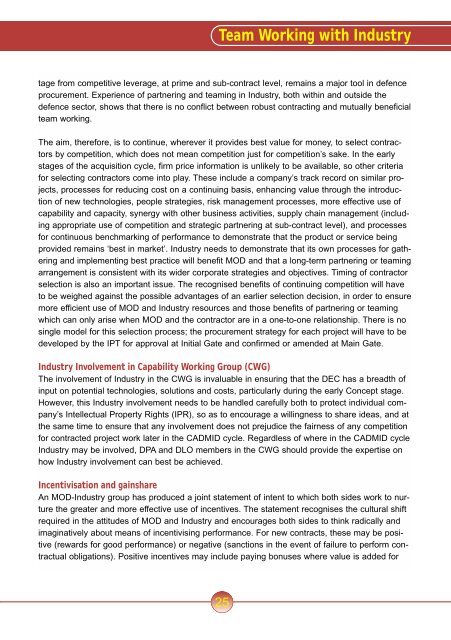The Acquisition Handbook
The Acquisition Handbook
The Acquisition Handbook
- No tags were found...
Create successful ePaper yourself
Turn your PDF publications into a flip-book with our unique Google optimized e-Paper software.
Team Working with Industrytage from competitive leverage, at prime and sub-contract level, remains a major tool in defenceprocurement. Experience of partnering and teaming in Industry, both within and outside thedefence sector, shows that there is no conflict between robust contracting and mutually beneficialteam working.<strong>The</strong> aim, therefore, is to continue, wherever it provides best value for money, to select contractorsby competition, which does not mean competition just for competition’s sake. In the earlystages of the acquisition cycle, firm price information is unlikely to be available, so other criteriafor selecting contractors come into play. <strong>The</strong>se include a company’s track record on similar projects,processes for reducing cost on a continuing basis, enhancing value through the introductionof new technologies, people strategies, risk management processes, more effective use ofcapability and capacity, synergy with other business activities, supply chain management (includingappropriate use of competition and strategic partnering at sub-contract level), and processesfor continuous benchmarking of performance to demonstrate that the product or service beingprovided remains ‘best in market’. Industry needs to demonstrate that its own processes for gatheringand implementing best practice will benefit MOD and that a long-term partnering or teamingarrangement is consistent with its wider corporate strategies and objectives. Timing of contractorselection is also an important issue. <strong>The</strong> recognised benefits of continuing competition will haveto be weighed against the possible advantages of an earlier selection decision, in order to ensuremore efficient use of MOD and Industry resources and those benefits of partnering or teamingwhich can only arise when MOD and the contractor are in a one-to-one relationship. <strong>The</strong>re is nosingle model for this selection process; the procurement strategy for each project will have to bedeveloped by the IPT for approval at Initial Gate and confirmed or amended at Main Gate.Industry Involvement in Capability Working Group (CWG)<strong>The</strong> involvement of Industry in the CWG is invaluable in ensuring that the DEC has a breadth ofinput on potential technologies, solutions and costs, particularly during the early Concept stage.However, this Industry involvement needs to be handled carefully both to protect individual company’sIntellectual Property Rights (IPR), so as to encourage a willingness to share ideas, and atthe same time to ensure that any involvement does not prejudice the fairness of any competitionfor contracted project work later in the CADMID cycle. Regardless of where in the CADMID cycleIndustry may be involved, DPA and DLO members in the CWG should provide the expertise onhow Industry involvement can best be achieved.Incentivisation and gainshareAn MOD-Industry group has produced a joint statement of intent to which both sides work to nurturethe greater and more effective use of incentives. <strong>The</strong> statement recognises the cultural shiftrequired in the attitudes of MOD and Industry and encourages both sides to think radically andimaginatively about means of incentivising performance. For new contracts, these may be positive(rewards for good performance) or negative (sanctions in the event of failure to perform contractualobligations). Positive incentives may include paying bonuses where value is added for25
















